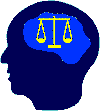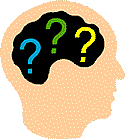 | The Prefrontal Cortex and Moral Behavior |  |
 | The Prefrontal Cortex and Moral Behavior |  |
| November 11, 1999 On September 13, 1848, railroad worker Phineas Gage was involved in an accident that drove a three-foot long iron bar through his skull. Although Mr. Gage survived, his behavior changed drastically. He went from being a hard-working, well-liked laborer to a gruff, rude, foul-mouthed drifter. Examination of Mr. Gage's skull has revealed that he suffered damage to the frontal lobes of his brain. The primary area of injury was to a part of the prefrontal cortex called the orbitofrontal cortex. |
 The skull of Phineas Gage. |
 Approximate location of the prefrontal cortex |
Over 150 years later, there is more evidence that the prefrontal cortex may be important for moral behavior. Adults who suffer damage to the prefrontal cortex develop problems with making decisions and with behaving appropriately in social situations. Scientists at the University of Iowa have published a report (Nature Neuroscience, November 1999) about two adults who suffered prefrontal cortex damage when they were very young children. These two individuals had severe behavioral problems including impaired decision-making ability and "defective social and moral reasoning." |
The Subjects
| |||||
 The
scientists found that these two people had normal intelligence based on
memory tests, language skills, math and problem-solving ability. However,
they had problems with learning the rules and strategies of tests. For
example, if they were given different rewards for selecting cards from
four different decks of cards, they could not learn which deck of cards
gave them the best reward.
The
scientists found that these two people had normal intelligence based on
memory tests, language skills, math and problem-solving ability. However,
they had problems with learning the rules and strategies of tests. For
example, if they were given different rewards for selecting cards from
four different decks of cards, they could not learn which deck of cards
gave them the best reward. The researchers also asked the subjects about real-life situations involving dilemmas and conflicts. For example, the subjects were asked what would be the right thing to do if a man had to steal a drug to save his wife's life. The subjects were also asked about what they would do if two people disagreed on which TV show to watch. Both subjects failed to come up with solutions to these problems and could not even identify the problems in the situations. The scientists estimated that the subjects had the moral reasoning of 10-year-old children. Because there were only two subjects in this study, it is difficult to say with certainty that all people with damage to the prefrontal cortex will experience problems with moral behavior. Also, it is possible that people WITHOUT any apparent damage to the prefrontal cortex may also show these "psychopathic" behaviors. Nevertheless, this study suggests that the prefrontal cortex does play a role in the development and maintenance of moral behavior. |
|
References and further information:
|
| BACK TO: | Neuroscience In The News | Table of Contents |
![[email]](./gif/menue.gif) Send E-mail |
![[newsletter]](./gif/menunew.gif) Get Newsletter |
![[search]](./gif/menusea.gif) Search Pages |